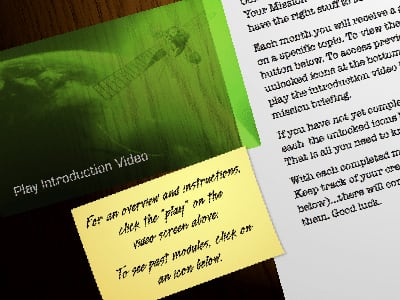In all seriousness, any conscientious designer who creates training or learning assets designed to influence human behavior or elicit change perpetually seeks the ways and means to make the content more compelling and more engaging.
There are several proven strategies:
- Using video – who hasn’t learned how to do something by watching a YouTube video?
- Connecting learning to the bottom line – learners should be aware of the opportunity cost of them not knowing what we are trying to teach them.
- Unlocking the navigation – learners can move through the learning at their own pace, speeding through content they’re familiar with and going back to review when necessary.
- Mobile devices – content should be available at the point of need, and users are rarely very far away from their devices.
This is just a short sampling of the methods available. A quick search for “engaging and compelling” brings up 58 million hits on a search engine. So I’m obviously not the first to take a stab at the topic, but I’m hoping to provide you with a few insights. Here’s my take…
Over the holidays, (don’t tell my boss) I spent some time resting and senselessly browsing the ever-growing libraries of fantastic (and not so fantastic) shows, movies, and documentaries brought to me by all the content-creating powerhouses such as Netflix, Amazon, Hulu, and HBO (to name a few). As I was diving into a show or a movie, I found myself – more often than I would have expected – just as quickly jumping out because what I was watching just didn’t do it for me. I clicked play, browsed some more, tried a new show, different provider… And then a vision hit: the film libraries transformed into an LMS and the individual visual assets (movies, series, etc.) morphed into courses. Nobody forced me to watch any given piece, but I could find what I needed when I needed it. So here is the first recommendation I can confidently make based on my analysis of the streaming services model as it applies to the learning game.
If you want your content to be compelling and engaging:
1. Make It Easy to Find
The movie analogy is apt: the algorithm that suggests movies or shows learns from my viewing behavior and preferences and suggests topics that might correspond to my needs. Think of it as a flexible curriculum. But what happens if I want to explore something different? That’s where categories came in.
You might be thinking that finding where a course is located has nothing to do with the content itself, but the ease of access is critical. Of course, if there is training your employees must take, you can just send them a direct link and that’s that. The opportunity cost is that the learner consumes the content without any context in terms of related learning assets.
Just imagine a user-friendly, visual, and intuitively organized library containing all of your available courses versus a cluttered, outdated, often locked or restricted LMS or SharePoint. Generally speaking, not being able to find something you’re looking for (your car in a parking lot, your shoes) creates frustration and a general souring of mood, and the same is true of learners. You can influence their experience by simply providing an easy, intuitive path to the learning they need.
2. Pull Them In
I love movie previews. Time is precious, and previews help me decide if a movie is worth the investment. I’m aware that previews are designed expressly to lure me in, so I know I’ll see the flashiest scenes and best acting snippets, but the preview still helps me form an impression of what’s coming and prepares me for the viewing experience.
How does this translate to learning? The similarities are striking. Imagine distilling the gist of a learning program or even a single course or workshop into a short 2-3-minute-long preview (infomercial). It would include messages such as:
- Why this training/topic is important.
- What is in it for you as a learner.
- How your performance will improve once they’ve taken the course.
- How long it will take, and how it can best be consumed.
From our experience, these learning videos or explainer videos have inherent positive value, but none as powerful as the attitude change. With a short preview such as this, you can turn a skeptical, busy, and maybe even frustrated reluctant learner into an employee who understands the context for the training and knows exactly what to expect. And the bonus is that, if designed and executed correctly, this short clip can deliver the most important learning points in a very visual and compelling way, such that if this were the only asset your learner laid eyes on they would still walk out with new knowledge or skills.
3. Now, Deliver
I found what I think is the perfect show. I really liked the preview…I am all in. Press ‘Play’! This is where the rubber meets the road. It is unfortunate that sometimes the preview looks good, the ratings are high…but the expectation just doesn’t match the reality. It happens, and it will very likely happen to you with your online learning assets. But every now and then, you’ll find the film or series that just sucks you in. Hours (sometimes days!) go by, and you cannot get enough of it. In my experience as a learning strategist, this can be achieved in the learning sphere as well. Binge learning – is it really a thing?! It is, though one must follow a couple of proven principles:
Make Me Care
I remember watching HBO’s True Detective (Season 1) and realizing how much I wanted to learn more about almost every single character in that show. Though a good part of that was due to the brilliant performances, the storytelling (storyboarding), the even distribution of plots and subplots (design), and the captivating dialogue (script) certainly helped.
How do you translate this into a tangible learning strategy?
- Make the Learner the Centerpiece of the Course
Target audience analysis comes in very handy here. The more you know about your learners, the better you can connect with them and fit the content directly to their needs. - Acknowledge or Create Complexity
The best movie or TV characters are complex. They are good and bad, they struggle, they fail, they overcome, they triumph. Help your learner feel understood. It is not humanly possible to remember everything from every course. Recognize and acknowledge that fact. Your job is to help your learner identify the key knowledge. Create and share tools they can use after the training. Or even better, design the training with integrated performance support so they can use it after the event itself. They don’t need to be able to recite all they learned, but they should be able to locate the information they will need. - Use Stories and Real-Life Examples
Have you ever noticed the attention shift once you learn the movie or the show you are about to watch is “based on a true story”, “inspired by true events” or, even better, is a biography or a recreation of the real event? The same can and does happen in learning. The theory, the definitions, the process steps, the exceptions, etc., are all important and valuable, but if you use case studies (the good and the bad – remember complexity!), examples, or samples you will breathe life into the theory, making it that much more relatable and hence memorable. - Create Cliffhangers
Who’s the murderer? Or, if we know who the killer is; are the perpetrators in jail or did they manage to escape? Can you figure out how they did it? Making your learner work towards something is solid. An easy way to execute this is to create a locked or hidden chapter/module in your course or create an infographic/quick reference guide that the learner will be able to download and use after the event.
Make Me Think
Even though watching a movie may seem, and often is, to be a passive form of entertainment and learning, it can be one of the most stimulating and hyper-effective entertainment and learning methods. You know, that feeling of being genuinely confused about the plot, and you’re trying to figure things out!? You’re often provided with a trail of clues which make you think, search, and explore just to get to a dead end as new facts or characters come into light. The ability to engage at this fundamental level (vs. through drag-and-drop or similar basic interactions) can be achieved in corporate Learning and Development. Here are a couple of approaches:
- Put Your Learner on The Spot Ask your serious learner a serious question. Ask something that may not have been covered yet. This can be achieved through an interactive, real-life case study with branching based on critical decision points or milestones within the story. Let the learner experience the consequences of their mistakes or the rewards of their knowledge. Nothing discourages me as a learner more than obvious multiple-choice questions at the end of each topic. I am not passing judgment of the form, but rather the execution. Which brings me to another important principle of engagement…
- Enable Critical Thinking Learning six bullet points for the final quiz is easy but thinking about and applying the essence of those six bullet points may be much more challenging. As adult learners, we don’t only learn the theory. Our life experience constantly cross-references new learning with our current reality. To leverage this is to inject the knowledge (those bullet points) into a dynamic scenario which brings in the real-world aspect and allows for visualizing future choices and behavior, thus enabling better retention and faster recall of the theoretical information. Just like in the movies, it’s our job to explain how a wormhole works, and then take you on a fantastic ride through one.
4. Make It Easy and Fun
This one is relatively simple. In movie making, there are proven and tested methods of storytelling, scriptwriting, camera work, etc. In the learning industry, we too have proven methods of ensuring the easiest possible way to learn new knowledge or skills. Some of the more obvious and effective ones are:
- Create a Series of Experiences
Blended learning has been proven to be one of the most effective practices and applications for contemporary adult learners. Since it accommodates any new technology or novel approach, there’s little risk that this strategy will fall to the wayside, as many trends in the sphere of human learning have done in the past. - Mind the Length!
Yes…I can take a 2-hour-and-40-minute long movie, but it has to be done right. Don’t create a 60-minute, web-based training when you can create a series of shorter, more impactful microlearnings or mini-modules. This will allow your learner to pause and come back to it in more coherent chunks and time slots. Don’t you, sometimes, have the feeling that a long movie would have been much better as a three-part miniseries? - Make It Look Good!
Or at least cohesive. Beauty is indeed in the eye of the beholder, but one thing is certain; we will always be attracted to shiny objects. From toddlers glued to the TV screen all the way through adults wanting to experience deep black on their new 4K Smart TV, it’s safe to say that a thought-out look and feel, and visually heavy learning assets will improve the experience and the outcome of learning. - Follow the Neuroscience (Or Hire A Pro)!
Scientists are learning new things about the brain every single day. It is becoming increasingly complicated to sift through the latest research and more complex to translate their findings into applicable, tangible strategies that can be employed to support your learner. The easiest solution to this issue is to hire a pro.
Custom eLearning content development is not exactly Hollywood, and your LMS may not ever be as sexy as Netflix, but the parallels are clear. Thinking about what entices us in our daily life and attempting to apply those lessons in the never-ending quest for the perfect eLearning course can be a stimulating learning experience.







